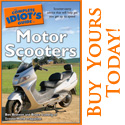
(BAM! Off the hinge! Even though the hinge broke, the head it was protecting didn’t.)

(The culprit tire. I’d show more photos… but it’s just so sad to see a beautiful new Vespa all tore up.)
Thanks to Fred at Idontgiveashift, Austin’s monthly long distance ride, for forwarding this on to us. This is the follow up to our story on the importance of wearing your gear. You remember what happend to Ruckuschick, right? Body covered in bacon, but her head? Intact.
Let’s take a look at what happens to a 200lb, 6ft sumthin’ guy who takes a scooter spill at 65 MPH. Thank goodness for the gear! On to the story of our friend “Sound of the day” Steve um… Joe. (Thanks for the GREAT narrative Christine! Very informative!)
Tires 1, Scooter 0 by Christine Fish
One of my scooter buddies (for the sake of our new friendship and to protect his identity, I’ll refer to him as Joe, rather than his real name), recently had an unscheduled dismount from his less-than-a-year- old Vespa Granturismo 200L. No other vehicles were involved and, thankfully, Joe is alive and mostly well (recovering from a mild concussion and bruises) to ponder lessons learned from the experience, share his story, and ride again. His account of the incident is a chilling reminder worth sharing of the importance of wearing full protective gear, performing routine maintenance checks, knowing your bike’s limits, and recognizing early warning signs of potential mechanical failure. With those points in mind, following is Joe’s story.
While driving home from work on a local freeway at 65 mph just before rush hour on a very hot Texas day, Joe felt his Vespa suddenly decelerate. It was the beginning of a nightmare that lasted only a few seconds, but one that he’ll likely remember for a long time. “Oh, great,” thought Joe, “am I out of gas?” His analog gas gauge and fuel warning light had taken some getting used to: he had learned the hard way how to judge the distance he could ride and at what speed when those indicators worked together. With a quick glance at the instrument panel, Joe saw that he had more than an adequate fuel supply. His bike’s quick, nonverbal reply was “No, but my watch my back!” as its rear end began to fishtail wildly.
A quick thinker with a cool head, Joe’s first instinct was to keep the bike upright long enough to get from the center lane of traffic to the nearest grassy spot on the side of the road. He had a hunch that something mechanical had just gone very wrong with the bike and that the odds of making a controlled stop were slim at best. Joe rolled off the throttle and countered the bike’s movements with aplomb while nudging it toward the grass. He managed to avoid cars and move out of the center lane, pointing the bike toward what he hoped would be a softer dismount point, if needed. Then he felt a sudden jolt, as if he had hit a bump or a hazard in the road.
The next thing Joe remembered was waking up on a stretcher in an ambulance with an emergency medical services (EMS) technician sticking an IV needle into his arm. Witnesses who stopped and called for help said that Joe’s back tire had blown out. From the pain in his left hip and head and the grass stains streaked across the lower left front panel, left sleeve, and across the back crash armor in his jacket, Joe knew that he had been launched from the bike and hit his intended target.
The emergency room physician concluded his assessment of the various x-rays and tests performed on Joe with, “Your helmet did its job. However, you have a concussion.” Indeed, the helmet saved Joe from a more severe injury and possibly even saved his life. Upon closer inspection of the flip-up model after the accident, both hinges were broken, with the jaw of the helmet hanging below the cheek guards. The face shield was missing, having been torn off during the crash, and the left back quadrant was streaked with a wide patch of scratches.
Joe’s wife smiled with relief as she pulled a large clump of grass and dirt out from under the edge of the Harley Davidson logo stud at the ankle on Joe’s left boot. She recalled her motorcycle safety training instructor explaining how important good, over-the-ankle protective foot wear is when riding a motorcycle and was glad that Joe had taken his safety gear purchases seriously. While assisting him in getting dressed to leave the hospital, she also noticed that the EMS technicians had kindly stuffed Joe’s gloves into his jacket pocket. Thank goodness Joe had been wearing them too.
On the way home from the hospital, Joe and his wife discussed several theories about how the back tire had been compromised and why Joe hadn’t noticed what in hindsight might have been warning signs of its impending demise. The tires were factory originals with slightly more than 5500 miles of wear. A little research on the Internet indicated that at least the rear tire was probably beyond end of life. Joe had noticed at the start of his last long ride about a week and a half before the accident that the back tire pressure was a little low. How long it had been that way, he wasn’t sure.
Upon closer inspection of the vehicle at the towing service the day after the accident, tread wear was evident on the back tire, but it was not obvious with a casual inspection. The wear was near the center of the tire, and it had cut a path sharply to the edge of the tread lines. Without picking up the bike, it was difficult to tell at the towing yard just how the tire failed or what might have delivered the final blow. But a few more facts are worth mentioning. On the day of the accident, the temperature outside was approximately 95 degrees when Joe left his office. Joe’s bike had sat outside all day in an open parking lot on hot asphalt. The tires had all day to bake in the sun for a nice hot ride home in the evening just before 5 p.m.– the hottest time of the day. Add to that the very pronounced tread wear near the center of the tire, an unknown time driven under-inflated, a tire beyond the usual end of life mileage for 12-inch tires, and a few lessons became obvious to Joe.
1. Know your tires.
While researching what went wrong and how he could have avoided the blow out, what surprised Joe was how little time he had actually spent researching information about his tires before he bought his scooter. Some FAQ sites that Joe found on the Internet cited average life expectancy for scooter tires at mileages much below what he had on his rear tire. His owner’s manual contained the usual warnings about checking the tires for proper inflation; maximum recommended pounds per square inch, watching for tread wear, and performing routine checks, but there was no direct mention about average mileage. Joe concluded from his research that it is important to know your tires before you buy, especially what is reasonable to expect from a specific tire (not all tires are alike) and when you should consider replacing them. Many factors affect mileage on tires, so general information about tire life expectancy can be misleading.Talk to your dealer, your scooter mechanic, and other scooter owners about their tire experiences. Research information from the manufacturer about the specific tires on your bike or that you are planning to buy. Joe found a wealth of information on the Internet about tire maintenance and many tips he would have never even considered without doing the research.
2. Inspect your tires.
Joe has a renewed appreciation for the motorcycle safety training that he attended, especially the lesson about checking his tires. He also found that published information abounds on the Internet about the importance of routine and thorough tire inspection, particularly inspecting tires for damage or possible problems areas (such as cracks, uneven tread wear, gashes, blisters, bumps, dry rot, or other signs of damage or uneven wear) as well as for adequate tire pressure. It’s easy to overlook tire inspection, especially as we’re rushing out the door to be somewhere at an appointed time or caught up in the excitement of an unplanned escape into the countryside. But consider this: all that’s between you and the road on your motorcycle are two little patches of rubber. Published recommendations vary about how often you should check the tires, but every time you ride isn’t unreasonable, considering how much you trust those two wheels! If you don’t feel comfortable with your ability to spot problems, consider taking your bike to a motorcycle dealer or vehicle inspection station and ask for an inspection. It’s not a substitute for your own regular inspection and certainly no guarantee that a problem will be spotted or prevented, but a trained eye that is used to seeing tires at their worst might see an early warning sign that you missed.3. Wear protective gear.
Joe was well-padded for his landing, something that I often don’t see in central Texas, especially in the heat of the late spring and summer months. Although both hinges on the flip top model were compromised from the impact, there’s little doubt that Joe’s helmet protected him from a much more serious head injury and possibly saved his life! And it’s not just crash protection that a helmet provides. Rocks, dust, and large insects flying in your face can be a safety hazard at any speed. Sure it can feel great to have the wind at your face. It’s by far better not to bet that you will still have a face, a healthy brain, or a life if you crash without a helmet. The odds simply aren’t in your favor.Joe was also wearing an armored, partial mesh motorcycle jacket. Without it, picture this: the pattern of grass stains on the left side, left arm, and across the back of his jacket replaced with road rash (or worse). Another friend of mine likes to counter objections to wearing protective clothing with this simple reply: “Skin graphs don’t always take.” Enough said. The same goes for wearing gloves, over-the-ankle, sturdy footwear, and riding pants or chaps. With so many choices available at local bike shops and on the Internet, and many that are adapted for warmer climates, there’s simply no good excuse for not wearing protective gear.
Joe was lucky that he survived the crash, and even more lucky that he survived with just a mild concussion and a painful lesson about tire maintenance. No doubt the experience has made him a safer rider. It certainly has been a not-so-subtle reminder to me, especially as we head into the heat of the Texas summer months, about the importance of routine maintenance and wearing protective gear.















22. June 2006 at 3:57 pm
Thanks so much for posting this. I’m going to inspect my Honda’s tires tonight and find out how long they’re supposed to last.
-Fran
22. June 2006 at 7:27 pm
woowee! Lucky guy! Glad he is ok.
23. June 2006 at 3:09 am
Harley or Helix, falling off ain’t fun.
Even on the stock Zuma it’s always helmet jacket and boots because like Dwayne Dibbley says, “you never know.”
23. June 2006 at 6:03 am
The last bit of gear I’m missing right now is a good pair of riding pants. I’ve been up to about 65 on my Reflex, and it’s not something I’m going to get used to quickly.
23. June 2006 at 7:39 pm
Just put a new rear tire on my wife’s Helix and ordered new Michelin S83′s for my Bajaj…should get them on next weekend. Can hardly wait!!
23. June 2006 at 8:22 pm
I always get a bunch of comments from friends who ride about the amount of gear I wear. Right now, it’s about 90 degrees and VERY humid just west of Boston. Sure, that’s not real hot by southern standards, but it’s darn hot to us.
I’m wearing:
Xpeed Ageis full face helmet
Teknic Supervent jacket
BMW Summer pants
High leather boots
Joe Rocket Velocity gloves.
Of course, I carry a change of footwear and zip off the lower part of the pants when off the scooter for comfort, but it’s always full gear when riding.
Rather sweat than bleed.
26. June 2006 at 12:54 pm
Thanks for posting this. It’s important to garner lessons from bad situations. I hope “Joe” makes a full recovery, and is able to ride again. It’s good to see that he was wearing full gear, as it can really make a difference.
Now if you’ll excuse me, I have to go check my tires.
28. June 2006 at 4:28 am
Glad this was… um.. inspirational for many of you. Baby needs a new set of tires here too.